#linkedin post generator ai
Explore tagged Tumblr posts
Text
AI-Powered Dashboard Tools for Monitoring LinkedIn Growth

LinkedIn has become the cornerstone for professional networking and brand-building. The AI-powered tools are utilized by professionals and businesses to analyze real-time profile performance and engagement metrics, making it possible for them to optimize their strategies and determine growth opportunities as well as ensure measurable results.
The Evolution of AI-Based LinkedIn Monitoring Tools
The dynamic ecosystem of LinkedIn requires constant optimization. AI-powered dashboard tools make this easier by automating data analysis, providing actionable recommendations, and presenting trends visually. These tools are indispensable for professionals looking to monitor their LinkedIn growth efficiently.
Key Features of AI Dashboards for LinkedIn
Comprehensive Metrics Analysis
AI dashboards are a rich source of information that shows the profile views, post engagement, and connection requests. These breakdowns help pinpoint what is working and where it is not.
Post Optimization Recommendations
The AI tool examines the performance of the LinkedIn post, which then shows the aspects that work with the audience. It may change the tone, format, or posting time for increasing visibility.
Connection Analytics
Understanding your connections is important for LinkedIn growth. AI-powered dashboards track the demographics and industries of your audience, so you can focus on relevant connections that align with your goals.
Trend Tracking
AI tools detect emerging trends in your industry by analyzing the performance of posts and profiles in your network. Staying ahead of these trends ensures you remain competitive in your niche.
Customized Alerts and Suggestions
You get real-time alerts for profile updates, new connection opportunities, or posts that need immediate engagement. AI ensures you never miss the most critical moments to engage with your network.
Benefits of AI-Powered LinkedIn Monitoring
Time Efficiency
AI automates time-consuming tasks like data collection and analysis. Instead of manually checking LinkedIn metrics, users can rely on AI dashboards to provide relevant insights quickly.
Data-Driven Decisions
AI tools eliminate guesswork by providing exact data on which strategies work best. Users can adjust their approach to LinkedIn based on facts rather than assumptions.
Increased Visibility
Users can increase the visibility of their profile by using AI guidance to tailor content and engagement strategies to their target audience.
Customized Growth Strategies
AI dashboards are goal-oriented, be it increasing followers, improving post engagement, or building meaningful connections.
Famous AI Tools for Monitoring LinkedIn
The following are various AI-powered dashboard tools that respond to the LinkedIn user:
Post Generator AI-LinkedIn
Users can use it to create perfect post ideas based on their industry's trends and user preferences. Its user-friendly interface enables professionals to achieve an active existence without spending an hour on it.
LinkedIn AI Tool for Profiling Optimization
Designed to improve your profile, this tool offers tailored suggestions to enhance your headline, summary, and skills section, ensuring your profile stands out.
Chrome Extension for LinkedIn Growth Tracking
Seamlessly integrating with your browser, LinkedIn Chrome extensions offers real-time insights into profile views, contact details, and engagement trends directly from LinkedIn.
AI for LinkedIn Posts and Engagement
These tools, by analyzing posting history and audience response, suggest ways to enhance likes, shares, and comments on your posts.
The Future of AI in LinkedIn Growth
The AI integration with LinkedIn monitoring tools is just the beginning. As the machine learning algorithm advances, the tools will be even more intuitive, predicting user behavior and offering highly personalized suggestions.
Future trends to watch include:
Deepen the predictive analytics function by predicting exact outcomes of strategic ideas for users who will take preemptive decisions.
Tools will better enlighten the nature of audience choice and thus yield better engagement numbers.
AI-based dashboards connect linkedin data sets with other websites and social network data to represent your online business.
Conclusion:
AI-powered dashboard tools are revolutionizing the way professionals interact with LinkedIn. With automation in analytics, providing data-driven recommendations, and saving precious time, these tools equip users to better optimize their presence on LinkedIn.
Investing in tools such as LinkedIn AI tools, Chrome extensions for LinkedIn, and post generators ensures that you are always on top of things in the professional world. AI is your passport to unlock LinkedIn's full potential and take networking and branding to unprecedented heights.
#ai for linkedin posts#linkedin ai#chrome extension for linkedin#linkedin extension for contact details#linkedin post generator ai
0 notes
Text
[Gritting my teeth to avoid leaving a bitchy comment on LinkedIn of all places]
#poll about 'how much of your resume is AI generated?' and there is not a 0% option#and i really would have liked to have been like#'why would you need an ai to write your resume? i wouldnt hire someone with an ai genrated resume. its giving lazy and inept'#but i chose not to because every comment you make on something posts up to your main profile#and i need a job right now so i'm afraid it'll make me look bad somehow#i am on linkedin at midnight because i cannot sleep and am having heart palpitations because of stress 🫠#so i am trying to do something about it by firing off a few applications
4 notes
·
View notes
Text
17.06 - "Should we expect any kind of change concerning content moderation?"
When asked about inclusive content and hateful/bigoted mods, Foldinho, one of Nexus' new owner, replied:
"[...] we fully intend to continue supporting moderation principles that make Nexus feel safe and inclusive. That foundation matters, and we won’t compromise on it."

Comment available on Dark0ne post
━━━━━━━━━━━━━━━━━━━━━━━━━━━━━━━━
17.06 - NexusMods' new owners, Marinus, Nikolai and Victor, posted a new pinned comment on Dark0ne's post to "clear the air on a few things"

Link to the post Full copy/pasted post and questions available in a reblog
━━━━━━━━━━━━━━━━━━━━━━━━━━━━━━━━
16.06 - Nexus Mods was acquired by Chosen, a company focused on growth and monetization of gaming startups.
Reddit thread

Dark0ne, creator and ex-owner of Nexus Mods, stepped down today in an update post:
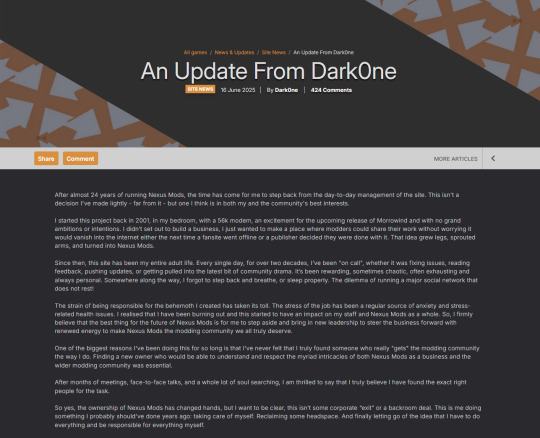
NexusMods post
Users on Resetera were able to found out more about this sudden change of ownership:
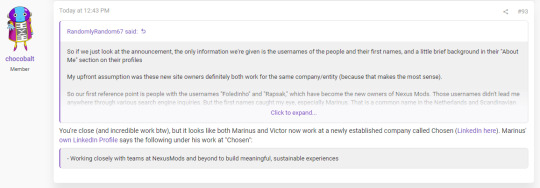
Resetera thread

Victor Folmann, CEO of Chosen, published this "Gaming Startup Monetization Cheat Sheet" on his LinkedIn

Link to the post
Users are already sharing their fear of NexusMods allowing more bigoted mods in the future, and taking down inclusive ones to follow the current "anti-woke" trend in the gaming industry


Reseta threada bout their change in moderation concerning bigoted mods following Oblivion Remastered launch
Another User, this time on NexusMods forum, noticed queer and inclusive mods being removed following Dark0ne's post

Link to the forum post
It is also worth mentioning that Chosen and its CEO are seen using AI generated images on their website (including generated images depicting Tracer from Overwatch) hyping up ChatGPT on his Linkedin account, and are including "rewarding gamers with crypto money"

Users speculate that Chosen buying out NexusMods is to potentially train an AI model that generates mods
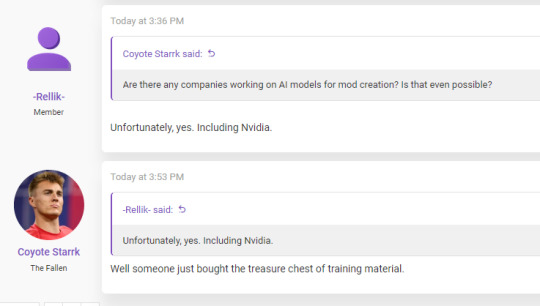
More about Nvidia's AI "RTX Remix" and future projects
#NexusMods#Nexus Mods#Chosen#long post#EDIT: updated the main post since people are missing on the updates!
8K notes
·
View notes
Text
Maybe this is something every generation goes through, but I feel I’ve now reached a certain age where I’ve realised a lot of older people in industries, and some people my own age are just so utterly full of shit.
Government innovation workgroups are the clearest example of this. Every big company is represented at these things - so and so from KPMG, PWC, Deloitte etc and they will attend a workgroup where they talk about nothing. They literally kick a ball around, and while they may publish a white paper, they never do the practical.
And they’ll take to LinkedIn and post about how they’ve contributed to the ‘AI Law’ workgroup. There’s no law to show for it, nothing has changed. It’s all just posturing, because no one who wants to attend these things wants to make a decision.
And I don’t have much hope for people my age to really change this because they’re being mentored by people who are utterly rudderless themselves.
156 notes
·
View notes
Note
Hey, am I overreacting or do some of the videos on the youtube channel @/FactsByBriggs contain ai generated images?
Here's the link to the channel if you need it: https://youtube.com/@factsbybriggs?si=QC-lGMhM9239_g5C
I don't usually tackle cases that are on youtube, but for the sake of investigating whether or not something is ai generated I'll do it.
(FUTURE A2T HERE: THIS IS GONNA BE A LONG ONE.)
Aaaaand right out of the gate I see AI.

However, I can't call this ai trash just because they generate art from ai.
The real deciding factor would involve a few things:
Does this channel tell people that some of the pictures are ai generated?
Does this channel credit any images they use online?
Are they using ai to mislead and/or farm content solely for monetization purposes?
Only one way to find out.

Ok, so right out of the gate, we don't see any links to images.

This guy also has a lot of socials.
....And a LinkedIn for some reason.
Let's put a pin on that for now.
What do the videos have to offer?
Ok. So we got an ai voice, an avatar that reeks of content farm garbage, and an image that has not been credited.
We're off to a good start. (in case you couldn't tell, that was sarcastic.)
What they didn't do is crop the url that is above, so we know the art got taken from somewhere.
Luckily, we have Google Lens.

That image is from @yuumei-art.
They took that image and did not credit where the image was from.
But, it gets better. IT'S NOT THE ONLY ONE.





There's even some where they even left the artist's signature! Not once, but twice.


And to answer your question, fellow anon, yes. They do use ai generated imagery as well.
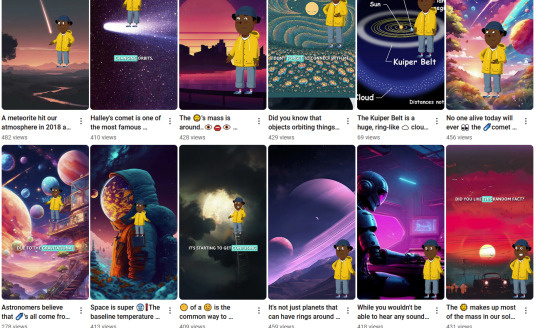
This channel is generating images or taking images from the internet for their videos.
No, this is not me hypothesizing. This is what they are actually doing.
I know this because in one video, they use a stock image with the watermark still intact.

But let's take a step back for a mo'. We need to investigate that LinkedIn account.

I have no idea why they have this account here. Like, at all.
LinkedIn is a job hunting website, not TikTok!

The link they have goes back to their Linktree.
Another thing to point out is that they have a Kofi page.
Well, BuyMeACoffee.
Same difference.

There doesn't seem to be anyone supporting that page.
Looking at this channel some more, this doesn't seem to be a content farm.
It has the stench of one, for sure. But it's also responding to comments.


Feeling like I've hit a dead end, I dropped "Facts by Briggs" on google.
That's when I learned that Facts By Briggs actually has a tumblr page.
....It's just not advertised on the Linktree.
And they have their own tumblr domain.
....wait, tumblr domains cost 22 bucks (18.02 pounds sterling in the UK). Isn't Briggs struggling with financial stuff?
...Something's not adding up.
They reblog posts from a London Hip-Hop DJ and Rapper by the name of CANMKING.

I was going to let this fact pass. But...

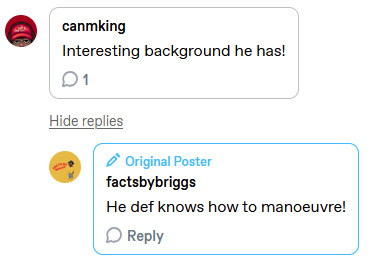

And yes, he is a real guy.

But let's get back on topic.
What's even stranger is that Can isn't the only one of the usual suspects that replies.

ctkvi, the people that made an album cover for Can.
They too have a linktree and a tumblr domain.
They also do ai video and music work.
And upon investigating those guys...

"Instagram Growth Service"?
Ok, the LinkedIn accounts are starting to make sense.
Let's tackle that monstocity another day, because it looks pretty daunting.
As for the avatar...

Google Lens saved me again, and that led me to Adobe Express.

And lookie here!
It's Briggs!

And considering that its a part of the Adobe Express ecosystem, I can probably infer that the whole video is made on Adobe Express.
Along with some of the other projects that CANMKING has done.
"Riley Frankcap"

Yes. This man made another one.
Better yet, Can has a total of 6 accounts.
And they reply to all of his stuff.

ongawdclub is the oldest of the alts, going as far back as December 2021, but Can has been on tumblr since 2011.
...
Huh. Looks like this case does involve this fellow hellsite after all.
Ok that's enough rabbit hole digging for today. Also I've hit the image limit on this post. Needless to say, there's a whole lot to unpack.
TL;DR:
Yes, Facts by Briggs is a content farm.
Yes, it uses ai art. BUT...
It also uses images off the internet and doesn't credit artists.
Briggs himself is not an original creation, but an avatar that you can easily use on Adobe Express. It's probably how most of the videos were created.
Facts by Briggs has a lot of social media accounts, as seen on their Linktree, including one on LinkedIn and one on a Kofi-like site.
What Facts by Briggs doesn't have on the Linktree is a tumblr. One that has a domain. This goes against what was said in the Kofi, which states that they are struggling with money.
Facts by Briggs reblogs posts by a London hip-hop dj/rapper named CANMKING.
CANMKING replies and reblogs numerous posts by Facts by Briggs, along with five other accounts (reallysmalls, ongawdclub, needgoodgraphics, ctkvi, and rileyfrankcap (A news based content farm). Facts by Briggs also replies to posts made those five accounts. CANMKING is the oldest account out of the total seven, so we assume that the six are sockpuppets that astroturf his tumblr posts.
ctkvi deals with ai video and audio, and needgoodgraphics has a service that, and I'm probably guessing here at the moment, artificially boosts your instagram account by astroturfing it.
TL;DR for the TL;DR:
CANMKING is a rapper/dj from London who uses sock puppets, astroturfing, bots, content farms, and straight up kofi scams to gain success.
...and he made those content farm videos all in Adobe Express.
To prove it, I reverse engineered a Facts by Briggs video.
Mostly.... I know Facts by Briggs uses ai voices... but I don't want to make another account just to access the ai voice add-on. So I used the legendary "Why You Lying?" instead.
I only found one post that talks about CANMKING's scamming efforts, but they've only scratched the surface.
If any of you have any more info about CANMKING that's not listed up here, do let me know.
#case type: scam#case type: astroturfing#case type: sockpuppeting#case type: bot#case type: ai scumbaggery#long post#case: CANMKING
100 notes
·
View notes
Text
I hadn't even thought about LinkedIn for years, but uhhh I just got this email:

I've copied the text below this cut if you can't/don't want to read a screenshot:
Hi Elizabeth,
You’re receiving this email because we’re making updates to LinkedIn’s User Agreement and have provided you more information in our Privacy Policy.
While we encourage you to read both, here’s a quick look at what you should know:
Updates to the User Agreement, which are effective on November 20, 2024, include more details on content recommendation and content moderation practices, new provisions relating to the generative AI features we offer, and license updates designed to help creators expand their brand beyond LinkedIn.
As our product evolves to leverage generative AI, we have given you more information in our Privacy Policy by adding language on how we use the information you share with us to develop the products and services of LinkedIn and its affiliates, including by training AI models used for content generation (“generative AI”) and through security and safety measures.
At this time, we are not enabling training for generative AI on member data from the European Economic Area, Switzerland, and the United Kingdom. For those outside these regions, we’ve proactively made available an opt-out setting for any members who choose not to make this information available for this purpose.
For more information, please visit our frequently asked questions, or our post on LinkedIn. By continuing to use LinkedIn, you are agreeing with these terms.
We remain committed to being transparent about our practices and keeping you in control of the information you entrust with us.
#byyyyye#'proactively made available an opt-out setting' somehow i doubt it's the default but we'll see if i can remember my password and delete :)#anghraine babbles#long post#linkedin#glorified autocomplete#anghraine rants
37 notes
·
View notes
Text
scrolling on linkedin is so funny bc every other post on my feed is like “psa to writers: we can tell when you use generative ai! one of the major tells is the use of words, phrases, or sentences to convey ideas”
13 notes
·
View notes
Text
"ChatGPT confused rooks for bishops, missed pawn forks and repeatedly lost track of where pieces were -- first blaming the Atari icons as too abstract, then faring no better even after switching to standard chess notations," Caruso wrote in a LinkedIn post.
Yeah, this is not surprising.
ChatGPT does not have a model of a chess board. It isn’t tracking the spatial relationships between pieces. It’s only generating descriptions of chess moves, either in prose or chess notation.
People seem to think that LLMs are some kind of general purpose AI, but they’re really not. They are designed to generate text. People have used that to do some other things, because programming is made of text, but ChatGPT still lives in a sea of words that are divorced from their actual meaning because it can’t experience the world and associate words to things in it.
10 notes
·
View notes
Text
What’s Next for AI Chrome Extensions on LinkedIn: Trends to Watch

The integration of AI tools with LinkedIn is changing how professionals network, engage, and build their online presence. AI Chrome extensions for LinkedIn are leading this change in unprecedented automation and personalization.
TheTrends to Look out for in the Future:
1. Smarter post generation
AI for LinkedIn posts is becoming more intuitive. Tools are evolving to generate content that aligns with industry trends, personal tone, and audience preferences, allowing professionals to post impactful updates with ease.
2. Improved Personalization
LinkedIn AI tools now write highly personalized connection requests and messages. As AI becomes more sophisticated, these tools will leverage deeper analytics to further tailor communication, making interactions more engaging and meaningful.
3. Advanced Profile Insights
Chrome extensions about LinkedIn will focus on scanning deep into people's profiles. Such insight will help one understand the connections better based on their skills, experience, and engagement patterns for more profound and targeted networking opportunities.
4. Contact Management
One of the most important aspects is contact management on LinkedIn. Growing networks requires better management of contacts. AI- powered extensions for contact information on LinkedIn will likely provide even better organization, categorization, and tracking of one's connections, making maintaining relationships even easier over time.
5. Seamless Integration with Other Platforms
Future AI Chrome extensions will probably integrate LinkedIn with CRM tools, email marketing platforms, and calendar apps. This will allow professionals to streamline their workflow and manage LinkedIn activities alongside other business operations.
6. Automated Outreach Campaigns
Extensions are likely to handle bulk personalized outreach while maintaining authenticity. They will use AI to create customized templates and adjust messaging based on recipient profiles, thereby maximizing response rates.
7. Improved Security and Compliance
As privacy concerns grow, these tools will need to adopt stricter compliance with LinkedIn’s policies and global data regulations. This will ensure safe and ethical use of AI for LinkedIn automation.
8. AI-Driven Insights for Networking Trends
AI will help users identify networking trends, such as the best times to post, topics gaining traction, or people to connect with based on shared interests and goals.
Conclusion
AI Chrome extensions are changing LinkedIn productivity. Bigger trends in smarter personalization, better insights, and seamless integration all play along to making professionals' networking more efficient than ever. Updates on such advancements become important for maximum LinkedIn utilization.
Look into the cutting-edge LinkedIn AI tools of today and keep your lead in the network game.
#ai for linkedin posts#linkedin ai#chrome extension for linkedin#linkedin extension for contact details#linkedin post generator ai
0 notes
Note
mx kendra, do you have any advice for job hunting? I'm about to start looking(again), but its always so intimidating - have a lovely day!
how it feels to start job hunting in the 2020s:

but yes i have advice for you anon! last time i went job hunting i got serious enough where i was reading 'askamanager' blogs and shit like that to really make sure i wasn't wasting my effort
so kendra's advice to job hunting in the most effort effective way:
first and most importantly is to understand that job hunting rn is simply a numbers game. it's not you it's just that the society we're living in is full of shit. for every 10 job postings, 4 are fake, 1 has an internal candidate in mind already, 3 are just posting jobs to look good and the rest are legit but slow af
bc job hunting is a numbers game its easy to be discouraged if you're not receiving responses consistently as proof that you're not just throwing shit into the void so its superrr imperative to try your best to apply to legit jobs. ive found my best success using indeed as a method of jobs being brought to me and then going on the company website myself and applying. this also doubles as a way to make sure a job posting/company is real
keep a spreadsheet of applied jobs. i just googled 'job application spreadsheet template' and picked one of the first ones i saw, made a copy, and then modified it to suit my needs. keeping a spreadsheet was one of the best things i did bc it can help keep track of jobs you've found and haven't applied to/ones you have applied to/and if you're like me and had a goal of getting a state job i could pre-empt when the interview requests were gonna come in lol 😭
resumes/cover letters. whew. probably the most important part of job hunting. ai scanning or not its a good rule of thumb to have skills mentioned in the job description to match the job posting. what i did was dedicate a folder in my google drive to job stuff and made a folder for each kind of jobs i was interested in. from there i would find a job i wanted to apply to and tailor an old resume to have a bunch of the shit mentioned in the posting on the new resume. i'd save it in the appropriate folder with the date i edited it. if you haven't been in the habit of tailoring your resume you may be doing this a lot but eventually you'll have so many variations you won't have to do much editing if at all. and i do the same with cover letters. i have a general template for my cover letter and then tweak them for each kinds of jobs im looking for. this + ditching linkedin helped me A LOT
create an interview cheatsheet. you probably already know the job hunting sphere has a language and culture all its own. personally as someone with a touch of the 'tism it do not make sense to me so i have unknowingly not navigated interviews as well as i could have. what's helped? ask a manager. seriously. miss allison has helped me blend in as a normie soooo much 😭😭😭😭 if you have any specific questions/have any specific weaknesses just search the site but what really helped me was the list of good interview questions. oh and for the longest i could never come up with a good question to ask my interviewer but one day google recced me this article and now every time i ask 'so what would separate a good candidate from an excellent candidate in this role' and when i tell you my interviewers gag every time lollllll. i also went through 'boost your interview iq' [pdf download link here <3] and jotted down notes on how i can answer common interview questions to quickly be able to go over the night before
study the job posting before the interview btw and try to drum up at least one correlating anecdote for some of the major points of the job bc they WILL ask you that lollllllll
#asks#after doing a bunch of research on job culture stupidity it really helped teehee#bc i really did think they meant to talk abt yourself not your qualifications.....
25 notes
·
View notes
Text
LinkedIn is using its users’ data for improving the social network’s generative AI products, but has not yet updated its terms of service to reflect this data processing, according to posts from various LinkedIn users and a statement from the company to 404 Media. Instead, the company says it will update its terms “shortly.”
Time to shitcan LinkedIn. Sadly, there's not much in the way of alternatives out there since most job sites appear to be swarming with bots that waste your time. If anyone knows different, please reply here.
22 notes
·
View notes
Text
On paper, the first candidate looked perfect. Thomas was from rural Tennessee and had studied computer science at the University of Missouri. His résumé said he’d been a professional programmer for eight years, and he’d breezed through a preliminary coding test. All of this was excellent news for Thomas’ prospective boss, Simon Wijckmans, founder of the web security startup C.Side. The 27-year-old Belgian was based in London but was looking for ambitious, fully remote coders.
Thomas had an Anglo-Saxon surname, so Wijckmans was surprised when he clicked into his Google Meet and found himself speaking with a heavily accented young man of Asian origin. Thomas had set a generic image of an office as his background. His internet connection was laggy—odd for a professional coder—and his end of the call was noisy. To Wijckmans, Thomas sounded like he was sitting in a large, crowded space, maybe a dorm or a call center.
Wijckmans fired off his interview questions, and Thomas’ responses were solid enough. But Wijckmans noticed that Thomas seemed most interested in asking about his salary. He didn’t come across as curious about the actual work or about how the company operated or even about benefits like startup stock or health coverage. Odd, thought Wijckmans. The conversation came to a close, and he got ready for the next interview in his queue.
Once again, the applicant said they were based in the US, had an Anglo name, and appeared to be a young Asian man with a thick, non-American accent. He used a basic virtual background, was on a terrible internet connection, and had a single-minded focus on salary. This candidate, though, was wearing glasses. In the lenses, Wijckmans spotted the reflection of multiple screens, and he could make out a white chatbox with messages scrolling by. “He was clearly either chatting with somebody or on some AI tool,” Wijckmans remembers.
On high alert, Wijckmans grabbed screenshots and took notes. After the call ended, he went back over the job applications. He found that his company’s listings were being flooded with applicants just like these: an opening for a full-stack developer got more than 500 applications in a day, far more than usual. And when he looked more deeply into the applicants’ coding tests, he saw that many candidates appeared to have used a virtual private network, or VPN, which allows you to mask your computer’s true location.
Wijckmans didn’t know it yet, but he’d stumbled onto the edges of an audacious, global cybercrime operation. He’d unwittingly made contact with an army of seemingly unassuming IT workers, deployed to work remotely for American and European companies under false identities, all to bankroll the government of North Korea.
With a little help from some friends on the ground, of course.
christina chapman was living in a trailer in Brook Park, Minnesota, a hamlet north of Minneapolis, when she got a note from a recruiter that changed her life. A bubbly 44-year-old with curly red hair and glasses, she loved her dogs and her mom and posting social justice content on TikTok. In her spare time she listened to K-pop, enjoyed Renaissance fairs, and got into cosplay. Chapman was also, according to her sparse online résumé, learning to code online.
It was March 2020 when she clicked on the message in her LinkedIn account. A foreign company was looking for somebody to “be the US face” of the business. The company needed help finding remote employment for overseas workers. Chapman signed on. It’s unclear how fast her workload grew, but by October 2022 she could afford a move from chilly Minnesota to a low-slung, four-bedroom house in Litchfield Park, Arizona. It wasn’t fancy—a suburban corner lot with a few thin trees—but it was a big upgrade over the trailer.
Chapman then started documenting more of her life on TikTok and YouTube, mostly talking about her diet, fitness, or mental health. In one chatty video, shared in June 2023, she described grabbing breakfast on the go—an açaí bowl and a smoothie— because work was so busy. “My clients are going crazy!” she complained. In the background, the camera caught a glimpse of metal racks holding at least a dozen open laptops covered in sticky notes. A few months later, federal investigators raided Chapman’s home, seized the laptops, and eventually filed charges alleging that she had spent three years aiding the “illicit revenue generation efforts” of the government of North Korea.
For maybe a decade, North Korean intelligence services have been training young IT workers and sending them abroad in teams, often to China or Russia. From these bases, they scour the web for job listings all over, usually in software engineering, and usually with Western companies. They favor roles that are fully remote, with solid wages, good access to data and systems, and few responsibilities. Over time they began applying for these jobs using stolen or fake identities and relying on members of their criminal teams to provide fictional references; some have even started using AI to pass coding tests, video interviews, and background checks.
But if an applicant lands a job offer, the syndicate needs somebody on the ground in the country the applicant claims to live in. A fake employee, after all, can’t use the addresses or bank accounts linked to their stolen IDs, and they can’t dial in to a company’s networks from overseas without instantly triggering suspicion. That’s where someone like Christina Chapman comes in.
As the “facilitator” for hundreds of North Korea–linked jobs, Chapman signed fraudulent documents and handled some of the fake workers’ salaries. She would often receive their paychecks in one of her bank accounts, take a cut, and wire the rest overseas: Federal prosecutors say Chapman was promised as much as 30 percent of the money that passed through her hands.
Her most important job, though, was tending the “laptop farm.” After being hired, a fake worker will typically ask for their company computer to be sent to a different address than the one on record—usually with some tale about a last-minute move or needing to stay with a sick relative. The new address, of course, belongs to the facilitator, in this case Chapman. Sometimes the facilitator forwards the laptop to an address overseas, but more commonly that person holds onto it and installs software that allows it to be controlled remotely. Then the fake employee can connect to their machine from anywhere in the world while appearing to be in the US. (“You know how to install Anydesk?” one North Korean operative asked Chapman in 2022. “I do it practically EVERYDAY!” she replied.)
In messages with her handlers, Chapman discussed sending government forms like the I-9, which attests that a person is legally able to work in the US. (“I did my best to copy your signature,” she wrote. “Haha. Thank you,” came the response.) She also did basic tech troubleshooting and dialed into meetings on a worker’s behalf, sometimes on short notice, as in this conversation from November 2023:
Worker: We are going to have laptop setup meeting in 20 mins. Can you join Teams meeting and follow what IT guy say? Because it will require to restart laptop multiple times and I can not handle that. You can mute and just follow what they say ...
Chapman: Who do I say I am?
Worker: You don’t have to say, I will be joining there too.
Chapman: I just typed in the name Daniel. If they ask WHY you are using two devices, just say the microphone on your laptop doesn’t work right ... Most IT people are fine with that explanation.
Sometimes, she got jumpy. “I hope you guys can find other people to do your physical I9s,” she wrote to her bosses in 2023, according to court documents. “I will SEND them for you, but have someone else do the paperwork. I can go to FEDERAL PRISON for falsifying federal documents.” Michael Barnhart, an investigator at cybersecurity company DTEX and a leading expert on the North Korean IT worker threat, says Chapman’s involvement followed a standard pattern—from an innocuous initial contact on LinkedIn to escalating requests. “Little by little, the asks get bigger and bigger,” he says. “Then by the end of the day, you’re asking the facilitator to go to a government facility to pick up an actual government ID.”
By the time investigators raided Chapman’s home, she was housing several dozen laptops, each with a sticky note indicating the fake worker’s identity and employer. Some of the North Korean operatives worked multiple jobs; some had been toiling quietly for years. Prosecutors said at least 300 employers had been pulled into this single scheme, including “a top-five national television network and media company, a premier Silicon Valley technology company, an aerospace and defense manufacturer, an iconic American car manufacturer, a high-end retail store, and one of the most recognizable media and entertainment companies in the world.” Chapman, they alleged, had helped pass along at least $17 million. She pleaded guilty in February 2025 to charges relating to wire fraud, identity theft, and money laundering and is awaiting sentencing.
Chapman’s case is just one of several North Korean fake-worker prosecutions making their way through US courts. A Ukrainian named Oleksandr Didenko has been accused of setting up a freelancing website to connect fake IT workers with stolen identities. Prosecutors say at least one worker was linked to Chapman’s laptop farm and that Didenko also has ties to operations in San Diego and Virginia. Didenko was arrested in Poland last year and was extradited to the United States. In Tennessee, 38-year-old Matthew Knoot is due to stand trial for his alleged role in a scheme that investigators say sent hundreds of thousands of dollars to accounts linked to North Korea via his laptop farm in Nashville. (Knoot has pleaded not guilty.) And in January 2025, Florida prosecutors filed charges against two American citizens, Erick Ntekereze Prince and Emanuel Ashtor, as well as a Mexican accomplice and two North Koreans. (None of the defendants’ lawyers in these cases responded to requests for comment.) The indictments claim that Prince and Ashtor had spent six years running a string of fake staffing companies that placed North Koreans in at least 64 businesses.
before the hermit kingdom had its laptop farms, it had a single confirmed internet connection, at least as far as the outside world could tell. As recently as 2010, that one link to the web was reserved for use by high-ranking officials. Then, in 2011, 27-year-old Kim Jong Un succeeded his father as the country’s dictator. Secretly educated in Switzerland and said to be an avid gamer, the younger Kim made IT a national priority. In 2012, he urged some schools to “pay special attention to intensifying their computer education” to create new possibilities for the government and military. Computer science is now on some high school curricula, while college students can take courses on information security, robotics, and engineering.
The most promising students are taught hacking techniques and foreign languages that can make them more effective operatives. Staff from government agencies including the Reconnaissance General Bureau— the nation’s clandestine intelligence service—recruit the highest-scoring graduates of top schools like Kim Chaek University of Technology (described by many as “the MIT of North Korea”) or the prestigious University of Sciences in Pyongsong. They are promised good wages and unfettered access to the internet—the real internet, not the intranet available to well-off North Koreans, which consists of a mere handful of heavily censored North Korean websites.
The earliest cyberattacks launched by Pyongyang were simple affairs: defacing websites with political messages or launching denial-of-service attacks to shut down US websites. They soon grew more audacious. In 2014, North Korean hackers famously stole and leaked confidential information from Sony’s film studio. Then they targeted financial institutions: Fraudulent trades pulled more than $81 million from the Bank of Bangladesh’s accounts at the New York Federal Reserve. After that, North Korean hackers moved into ransomware—the WannaCry attack in 2017 locked hundreds of thousands of Windows computers in 150 countries and demanded payments in bitcoin. While the amount of revenue the attack generated is up for debate—some say it earned just $140,000 in payouts—it wreaked much wider damage as companies worked to upgrade their systems and security, costing as much as $4 billion, according to one estimate.
Governments responded with more sanctions and stronger security measures, and the regime pivoted, dialing back on ransomware in favor of quieter schemes. It turns out these are also more lucrative: Today, the most valuable tool in North Korea’s cybercrime armory is cryptocurrency theft. In 2022, hackers stole more than $600 million worth of the cryptocurrency ether by attacking the blockchain game Axie Infinity; in February of this year, they robbed the Dubai-based crypto exchange Bybit of $1.5 billion worth of digital currency. The IT pretender scam, meanwhile, seems to have been growing slowly until the pandemic dramatically expanded the number of remote jobs, and Pyongyang saw the perfect opportunity.
In 2024, according to a recent report from South Korea’s National Intelligence Service, the number of people working in North Korea’s cyber divisions—which includes pretenders, crypto thieves, and military hackers—stood at 8,400, up from 6,800 two years earlier. Some of these workers are based in the country, but many are stationed overseas in China, Russia, Pakistan, or elsewhere. They are relatively well compensated, but their posting is hardly cushy.
Teams of 10 to 20 young men live and work out of a single apartment, sleeping four or five to a room and grinding up to 14 hours a day at weird hours to correspond with their remote job’s time zone. They have quotas of illicit earnings they are expected to meet. Their movements are tightly controlled, as are those of their relatives, who are effectively held hostage to prevent defections. “You don’t have any freedom,” says Hyun-Seung Lee, a North Korean defector who lives in Washington, DC, and says some of his old friends were part of such operations. “You’re not allowed to leave the apartment unless you need to purchase something, like grocery shopping, and that is arranged by the team leader. Two or three people must go together so there’s no opportunity for them to explore.”
The US government estimates that a typical team of pretenders can earn up to $3 million each year for Pyongyang. Experts say the money is pumped into everything from Kim Jong Un’s personal slush fund to the country’s nuclear weapons program. A few million dollars may seem small next to the flashy crypto heists— but with so many teams operating in obscurity, the fraud is effective precisely because it is so mundane.
in the summer of 2022, a major multinational company hired a remote engineer to work on website development. “He would dial in to meetings, he would participate in discussions,” an executive at the company told me on condition of anonymity. “His manager said he was considered the most productive member of the team.”
One day, his coworkers organized a surprise to celebrate his birthday. Colleagues gathered on a video call to congratulate him, only to be startled by his response—but it’s not my birthday. After nearly a year at the company, the worker had apparently forgotten the birth date listed in his records. It was enough to spark suspicion, and soon afterward the security team discovered that he was running remote access tools on his work computer, and he was let go. It was only later, when federal investigators discovered one of his pay stubs at Christina Chapman’s laptop farm in Arizona, that the company connected the dots and realized it had employed a foreign agent for nearly a year.
For many pretenders, the goal is simply to earn a good salary to send back to Pyongyang, not so much to steal money or data. “We’ve seen long-tail operations where they were going 10, 12, 18 months working in some of these organizations,” says Adam Meyers, a senior vice president for counter adversary operations at the security company CrowdStrike. Sometimes, though, North Korean operatives last just a few days— enough time to download huge amounts of company data or plant malicious software in a company’s systems before abruptly quitting. That code could alter financial data or manipulate security information. Or these seeds could lay dormant for months, even years.
“The potential risk from even one minute of access to systems is almost unlimited for an individual company,” says Declan Cummings, the head of engineering at software company Cinder. Experts say that attacks are ramping up not just in the US but also in Germany, France, Britain, Japan and other countries. They urge companies to do rigorous due diligence: speak directly to references, watch for candidates making sudden changes of address, use reputable online screening tools, and conduct a physical interview or in-person ID verification.
But none of these methods are foolproof, and AI tools are constantly weakening them. ChatGPT and the like give almost anyone the capacity to answer esoteric questions in real time with unearned confidence, and their fluency with coding threatens to make programming tests irrelevant. AI video filters and deepfakes can also add to the subterfuge.
At an onboarding call, for instance, many HR representatives now ask new employees to hold their ID up to the camera for closer inspection. “But the fraudsters have a neat trick there,” says Donal Greene, a biometrics expert at the online background check provider Certn. They take a green-colored card the exact shape and size of an identity card—a mini green screen—and, using deepfake technology, project the image of an ID onto it. “They can actually move it and show the reflection,” says Greene. “It’s very sophisticated.” North Korean agents have even been known to send look-alikes to pick up a physical ID card from an office or to take a drug test required by prospective employers.
Even security experts can be fooled. In July 2024, Knowbe4, a Florida-based company that offers security training, discovered that a new hire known as “Kyle” was actually a foreign agent. “He interviewed great,” says Brian Jack, KnowBe4’s chief information security officer. “He was on camera, his résumé was right, his background check cleared, his ID cleared verification. We didn’t have any reason to suspect this wasn’t a valid candidate.” But when his facilitator—the US-based individual giving him cover—tried to install malware on Kyle’s company computer, the security team caught on and shut him out.
Back in london, Simon Wijckmans couldn’t let go of the idea that somebody had tried to fool him. He’d just read about the Knowbe4 case, which deepened his suspicions. He conducted background checks and discovered that some of his candidates were definitely using stolen identities. And, he found, some of them were linked to known North Korean operations. So Wijckmans decided to wage a little counter exercise of his own, and he invited me to observe.
I dial in to Google Meet at 3 am Pacific time, tired and bleary. We deliberately picked this offensively early hour because it’s 6 am in Miami, where the candidate, “Harry,” claims to be.
Harry joins the call, looking pretty fresh-faced. He’s maybe in his late twenties, with short, straight, black hair. Everything about him seems deliberately nonspecific: He wears a plain black crewneck sweater and speaks into an off-brand headset. “I just woke up early today for this interview, no problem,” he says. “I know that working with UK hours is kind of a requirement, so I can get my working hours to yours, so no problem with it.”
So far, everything matches the hallmarks of a fake worker. Harry’s virtual background is one of the default options provided by Google Meet, and his connection is a touch slow. His English is good but heavily accented, even though he tells us he was born in New York and grew up in Brooklyn. Wijckmans starts with some typical interview questions, and Harry keeps glancing off to his right as he responds. He talks about various coding languages and name-drops the frameworks he’s familiar with. Wijckmans starts asking some deeper technical questions. Harry pauses. He looks confused. “Can I rejoin the meeting?” he asks. “I have a problem with my microphone.” Wijckman nods, and Harry disappears.
A couple of minutes pass, and I start to fret that we’ve scared him away, but then he pops back into the meeting. His connection isn’t much better, but his answers are clearer. Maybe he restarted his chatbot, or got a coworker to coach him. The call runs a few more minutes and we say goodbye.
Our next applicant calls himself “Nic.” On his résumé he’s got a link to a personal website, but this guy doesn’t look much like the profile photo on the site. This is his second interview with Wijckmans, and we are certain that he’s faking it: He’s one of the applicants who failed the background check after his first call, although he doesn’t know that.
Nic’s English is worse than Harry’s: When he’s asked what time it is, he tells us it’s “six and past” before correcting himself and saying “quarter to seven.” Where does he live? “I’m in Ohio for now,” he beams, like a kid who got something right in a pop quiz.
Several minutes in, though, his answers become nonsensical. Simon asks him a question about web security. “Political leaders ... government officials or the agencies responsible for border security,” Nic says. “They’re responsible for monitoring and also securing the borders, so we can employ the personnel to patrol the borders and also check the documents and enforce the immigration laws.”
I’m swapping messages with Wijckmans on the back channel we’ve set up when it dawns on us: Whatever AI bot Nic seems to be using must have misinterpreted a mention of “Border Gateway Protocol”—a system for sending traffic across the internet—with national borders, and started spewing verbiage about immigration enforcement. “What a waste of time,” Wijckmans messages me. We wrap up the conversation abruptly.
I try to put myself in the seat of a hiring manager or screener who’s under pressure. The fraudsters’ words may not have always made sense, but their test scores and résumés looked solid, and their technical-sounding guff might be enough to fool an uninformed recruiter. I suspect at least one of them could have made it to the next step in some unsuspecting company’s hiring process.
Wijckmans tells me he has a plan if he comes across another pretender. He has created a web page that looks like a standard coding assessment, which he’ll send to fake candidates. As soon as they hit the button to start the test, their browser will spawn dozens of pop-up pages that bounce around the screen, all of them featuring information on how to defect from North Korea. Then loud music plays—a rickroll, “The Star-Spangled Banner”—before the computer starts downloading random files and emits an ear-splitting beep. “Just a little payback,” he says.
Wijckman’s stunt is not going to stop the pretenders, of course. But maybe it will irritate them for a moment. Then they’ll get back to work, signing on from some hacking sweatshop in China or through a laptop farm in the US, and join the next team meeting—a quiet, camera-off chat with coworkers just like me or you.
7 notes
·
View notes
Text
The robots have come for your em dashes
Did you know em dashes are a sign of AI writing? Since when? Well, that’s what all the LinkedIn influencers say! Humans don’t use them in writing, right? They use hyphens. Of course we use em dashes—they’re basic punctuation marks! We use em dashes as a pause for emphasis—like I did in the first sentence in this paragraph—or to set off a quasi-parenthetical phrase, like I just did in this sentence. A hyphen is used to form compound words, or to break words by syllable at the end of lines. They’re not the same. Nobody better tell the influencers about en dashes; they’ll spontaneously combust. So where’d this idea come from? You got me, but I’d guess it stems from the nature of AI-generated text. It always shows a certain level of polish: no spelling or grammatical mistakes, complete sentences, a clear organization and structure. LLMs get this right in their “first drafts” because the majority of text they were trained on is itself polished—and it turns out that this level of polish covers the correct use of em dashes. Is there a better way to detect AI-generated text than looking for em dashes, then, smart guy? All generative AI is, by literal definition, statistically median, and this isn’t something that can be overcome by creative prompt engineering. Flair and personality in human writing comes from individualistic, quirky choices born of a writer’s likes, dislikes, and life experiences. LLMs don’t have any of those. So LLM-generated text tends to read like pleasantly anodyne business memos, or book reports by a precocious ninth-grader. So if the text you’re playing “robot or not” with is a business memo, a high school paper, or a blog post by the kind of LinkedIn influencer who thinks em dashes are a sign of AI writing, it might be a challenge. In other circumstances, it shouldn’t be. But it apparently is! The problem—and, dear reader, there is no gentle way to put this—a lot of ostensibly smart people neither write particularly well, nor read enough to get a sense of what good writing is like. Most of the writing they deal with—memos, emails, text messages, Amazon and Yelp reviews—is slapdash, unpolished. So if they come across anything in those contexts that looks refined yet relatively generic, they suspect ChatGPT. Apparently, we’ve so come to expect a lack of writing style from humans—and I mean style in the sense of Strunk & White, not in the sense of actual style—that we’re suspicious of it when we see it. If you don’t want your writing to be mistaken for AI, what should you do? Use “fuck” more often. To support my writing, consider a tip on Ko-fi.com. (originally published at Coyote Tracks)
7 notes
·
View notes
Text
New story, plus a publishing fiasco
This is a crosspost of my newsletter! If you’d like to get posts like this direct to your inbox or RSS reader, you can subscribe here.
Book publisher Unbound went into administration (functionally, bankruptcy proceedings) last month. They've been behind on royalty payments to authors for a while (and openly intend to keep not paying them for the foreseeable future). It also looks like, in at least one case, they were deliberately under-reporting sales of books to stiff an author on royalties (which they weren't paying anyway).
Even in the world of commercial publishing, this is an act of soul-sucking evil. The author in question, Aaron Reynolds, apparently scrapped an entire book while operating under the belief that his previous one had flopped—when, in reality, it had sold out its print run.
Unbound (now Boundless) has announced they intend to continue operating. I have no idea how. After this clusterfuck, I don't see any author in their right mind signing with them.
New Flash Fiction: "Fifth of November"

From what Jay had heard, people who’d been in war zones tended not to enjoy fireworks all that much—especially when those fireworks were going off randomly in their neighbourhoods. Moran hadn’t said anything about it, but their relationship (for lack of a better word) wasn’t exactly at the trauma-sharing stage.
Jay Moriarty and Sebastian Moran spend Bonfire Night together in this brief interlude, which takes place between "Sebastian Moran Gets Mauled by a Tiger" and "Jay Moriarty Ruins Everybody’s Childhood." You can read it for free here!
This Week's Links
Builder.ai collapses after revelation that its "AI" was hundreds of engineers
For eight years, Builder.ai marketed its "Natasha" AI system as a fully autonomous tool that could build software "as easily as ordering pizza." However, internal documents and employee accounts reviewed by Bloomberg paint a sharply different picture. Engineers in Noida and Bangalore manually coded client projects while being instructed to mimic AI-generated responses.
‘It’s a Weird Time to Be Rich Right Now’
“In times past, wealthy people were considered aspirational figures. Now, it’s more like, ‘If you’re wealthy, you did something wrong. You cannot be a billionaire without being a criminal. The system is stacked against the rest of us.’ And that has gotten louder and louder, and my clients are hearing it, and it’s disturbing to them.”
Tim Friede, Herpetologist
Tim Friede has made it his life goal to help scientists develop a universal anti-venom by allowing himself to be bitten repeatedly by venomous snakes.
---
I think I've figured out how to engagement-bait on LinkedIn. There is no way to use this power for good. Only evil.
-K
5 notes
·
View notes
Text
long angry rant post about boring shit incoming
had one of the most demoralizing work weeks in a while and then to top it off, i read an absolutely awful article from a top industry publication today that essentially ignores/totally delegitimizes the value of early career employees. it also said that AI could take a huge chunk of the “grunt work” from junior staff. the author didn’t even examine this bold statement or offer a counterpoint to consider.
if the “grunt workers” disappeared tomorrow from my industry, it would be catastrophic. and AI is not in a place to pick up that slack yet. it never will be, not fully! At this point AI has become a buzzy promise that arouses shareholders who don’t understand how much truly advanced AI technology actually costs.
but while AI can’t actually “take my job”, if shareholders want to see a better bottom line and mistakenly think AI could replace “grunt work” en masse, i have no doubt they’d support the layoffs of myself and my peers.
a group with this much output for dirt cheap should at least be considered an important part of the industry, and not a vestigial limb.
and no i’m not doing a lot of “high level” work right now. ideally, that’s what investment in upskilling and professional development is for. BUT that’s not what my industry is investing in. it’s actually mindboggling to see industry experts being so short sighted.
i know too many senior executives who should have the ~big ideas~ they’re being paid the big bucks for, but they consistently come in with lukewarm ideas. AND they don’t know how to use powerpoint or excel. no, i don’t have the skills right now to operate as a strategic project leader, but i can at least use microsoft office suite. what can you really do? i have SO many stories of jaw dropping ineptitude from senior execs. to paint this group as 100% integral to businesses while wholly ignoring the contributions of younger staff simply because of experience is kind of wild!
and yes i’m insecure. i hate feeling like im doing grunt work without any opportunities to take on new responsibilities. it makes me feel worthless!
but beyond my personal insecurities, it truly does bewilder me to see industry leaders pretending they won’t need a new generation of leaders in 20 years. where will effective leaders come from if you roll up the ladder behind you?
and i want to say all of this in a letter to the editor or as a reply to the article on linkedin, but i’ve been trained for years that my opinion doesn’t have any value whatsoever!
final cherry on top: i looked at the reposts of this article and one of these esteemed senior industry leaders reposted the article with: “yep, if you want [xyz] you can make due (his spelling error not mine) with a middle manager or even junior staff. but if you want growth and impact, you need a true expert with the confidence, command, and autonomy to sail that ship.”
hmm maybe you need some junior staff to proofread your linkedin shitposts, jackass. or you can use AI — i don’t really care. but clearly you’re unable to sail that ship by yourself. don’t you want to look buttoned-up and intelligent for your professional network? 🫶
#i know this is literally just a case study that should be in the appendix of das kapital but i am so tired of this#ignore me omg i just have to get this off my chest.#a post of mine
7 notes
·
View notes
Text
stepping outta my trash can and pulling up my internet clown pants:
let's talk about how u can tell executives are using AI to generate statements and memos
sweetie, that em dash you've been making fun of ppl for? that's for the Twilight proles not the AI-holes.
let's talk about the brand exonerative tense and brand marketing in layoffs statements.
writing crisis comms is a highly specialized field that requires years of experience, expertise and the ability to draft on the fly about some of the most difficult topics in industry. and of course... you gotta know the right outlets.
but when you use AI to modify or "refine" copy, you get statements that ring hollow because AI is only good at linguistic flattening. think of using AI to re-draft or revise statements as a whoopie cushion. honey, you know that's not a real fart.
let's take a look✨

what does it mean to "position Gaming for enduring success... to focus on strategic growth... to increase agility and effectiveness?"
here it doesn't just mean they're simply "following Microsoft's lead." now you're used to reading the exonerative tense in statements about war and policing. these often deliberately get rid of all human subjects and prefer passive voice, which is narrowly avoided here. but note that while a subject such as I, we or our does appear at multiple points, it's only to simulate the appearance of unanimous consent (3rd person authoritative: see monarchs and CEOs).
except for where we're talking about "employees who are affected." they are affected. but the cause slips through our linguistic fingers like wet sand. there is no actor, no sandcastle, simply an inevitable wave of change.
and well, except for all the headlines that in fact use that same passive linguistic structure to elide a subject.🙃

did the layoffs begin? omg how did that happen- someone had to rubber stamp it right? and someone is impacted. but there's not really an indication of anything beyond an overarching brand subject.
let's turn back to the Xbox CEO's statement and the phrase "our platform, hardware and game roadmap have never looked stronger."
AI generated corporate copy often contains brand reassurance statements like this one. these are marketing, even when featured in internal crisis comms, with the expectation of distribution by whatever means. with literally thousands of layoffs statements at their disposal, AI can be used to generate statements like this one either in whole or in this case, likely in part.
so let's tldr this.
does it sound flat? is it using words like "agile", "deliver + exceptional" multiple times in close proximity, and "thrive?"
it's not just CEO-speak. it's burying the digital hatchet with AI trained on publicly available and previous executive communications and LinkedIn posts.
optimized for brand resiliency.
workshopped for maximum shareholder satisfaction.
publicized on outlets voted "most likely to exclude the noun from the verb in ways that maximize reach"
welcome to the era of the Brand Exonerative Tense.
#microsoft#xbox#xbox layoffs#9100 people are losing their jobs#that's 4% of of the staff#ceos#because guys in $300 crew necks and jeans are overleveraged in stochastic parrots
4 notes
·
View notes